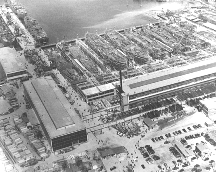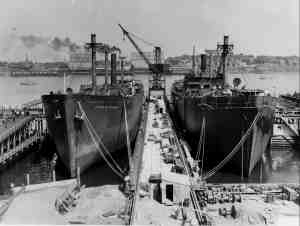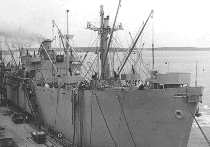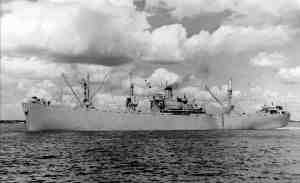|
The Liberty Ships of World War 2
 Maine
was still deep in the Depression when NewEngland Shipbuilding Corporation Maine
was still deep in the Depression when NewEngland Shipbuilding Corporation
built a shipyard in South Portland to complete a contract for 30 Ocean
Class
merchant ships desperately needed by Great Britain to survive the Nazi
attack.
In the summer of 1940, Holland, Belgium and France had fallen, and Great
Britain
was being threatened with invasion. The British were being pounded by
German
aircraft, but more important, her merchant marine was being sunk faster
than it
could be replaced. German submarines were sinking 5,000,000 tons per year
while
the British were only able to build 2,000,000 per year. For an island
nation
which could only produce enough to feed itself for two months of the year,
survival was at stake.
In 1940 the British asked for 60 vessels of 10,000 tons each to be constructed
in 24 months. The U.S. Maritime Commission working through Todd Shipbuilding
Company of New York selected Richmond, California and South Portland,
Maine as
sites to build the yards and construct the ships. They had to be of simple
design so that they could be mass-produced by unskilled workers to meet
the
emergency. Ocean Class ships were the early British version of Liberty
ships.
 The
East Yard of the South Portland shipyard was constructed first to fulfill
a The
East Yard of the South Portland shipyard was constructed first to fulfill
a
contract for 30 Ocean Class ships for the British. The West yard began
producing
freighters called Liberty ships before the 30 Ocean class ships were launched
and before Pearl Harbor. It launched the first American vessel in May,
1942. In
all, 30 Ocean class vessels and 236 Liberty ships were produced before
the
program ended in 1945.
Liberty ships were workhorses. They were simple square-hulled vessels
welded and
hammered out by the thousands. They were not especially fast or beautiful
and
they were expendable. The government believed that if one of these ships
was
able to deliver its cargo one time and was then sunk, it had paid for
itself.
Building a Liberty Ship
It was feared that ships built so fast and considered disposable would
fail—sunk
not by the enemy but by their own inadequacies. Welding the ships rather
than
riveting them made critics forecast failure, but welding meant that
inexperienced workers could be employed sooner, and the welding was faster.
The
workers initially produced a ship in 223 days but by the end of the war
that had
been shortened to 58 days from laying the keel to being moved to the fitting-out
pier.
 Thirty
thousand workers, largely inexperienced, came to the shipyard to build Thirty
thousand workers, largely inexperienced, came to the shipyard to build
these ships. Eventually 3,700 women were employed as tackers and burners,
machine workers, pipe coverers, spray painters,and crane operators.
The winter of 1943 was a particularly bad one with temperatures reaching
30 to
40 degrees below zero. The harbor froze over and yet the work went on,
round the
clock.
In all , these workers produced 30 Ocean Class and 263 Liberty ships between
1940 and 1945. Great areas of South Portland’s shoreline were filled
in and many
homes and lives were disrupted by this mammoth undertaking.
The East Yard was built first with six bays for the Ocean Class vessels
to be
built. They were constructed below sea level so that prefabricated
sections
could be lowered into them. When the ships were finished they could be
floated
out to the fitting out pier.
In 1941 the construction of the West Yard was begun. Six ways were built
in the
traditional manner with a seventh added later. There was also a fitting
out pier
on the West side.
The shipyard had several buildings to cut and shape the metal plates as
well as
prefabricate hull sections. A vast array of materials had to be stockpiled
to
keep up with construction. A railroad spur was built from the nearest
line to
the yard. Over 140 houses were moved or destroyed to make way for the
line and
the yard.
Thirty thousand workers produced 30 Ocean Class and 263 Liberty ships
between
1940 and 1945. Great areas of South Portland’s shoreline were filled
in and many
homes and lives were disrupted by this mammoth undertaking.
Routes and Cargo
 The
Liberty ships began by carrying goods to support the war effort in Great The
Liberty ships began by carrying goods to support the war effort in Great
Britain. It then became clear that if Russia was to stay in the war—and
we
desperately wanted Russia to stay in—we had to supply them with weapons,
gasoline,and food as well.
The Murmansk Run to Russia was the most feared because in the beginning
the
Liberty ships did not have military escort or weapons to defend themselves.
The
Germans had both surface and submarine ships poised in Norwegian fjords
ready to
attack the convoys. The first runs had little protection and were heavily
damaged. After the Americans came into the war convoys had more protection
but
the route itself from either Scotland or Iceland to Archangel was dangerous
with
rough seas and ice packs above the Arctic circle.
The Liberty ships carried supplies to North Africa and troops to the beaches
of
Normandy as well as support for the great Pacific fight against the Japanese.
Page 4 Tankers
{text}
page3
|